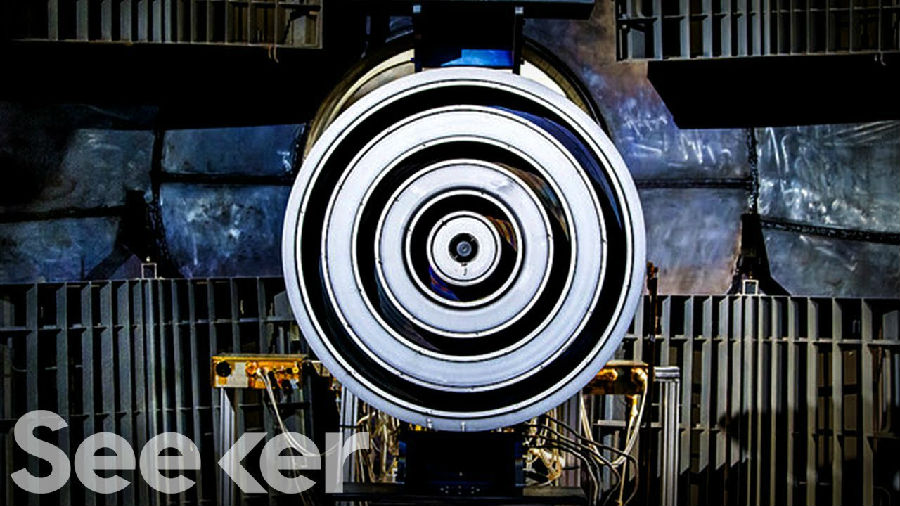“What you're seeing is this energetic blue-greenish plasma that comes out of the thruster.
“你看到的是来自推进器的高能蓝绿色等离子体。
It really looks like science fiction. It's very exciting.
看着特别像科幻小说里的场景,很振奋人心的。
In the end, we're supplying electricity through a wire and an inert gas
最后,通过用一根电线和惰性气体来供电,
and we turn it into this beautiful plasma that's moving at tremendous velocities that's providing thrust that may one day send people to Mars.”
把它变成美丽的,以惊人的速度移动,提供的推力或将能把人类送上火星的等离子体。
Chemical rockets are the workhorses of the space age, and they’ve had a pretty standard formula for the past 60 years.
化学火箭是太空时代的主力,过去的60年里有一个相当标准的程式了。
Get millions of pounds of liquid or solid fuel into a rocket, light it on fire with an oxidizer,
把几百万磅的液体或固体燃料置入火箭,用氧化剂点燃,
and then the speed of the propellant shooting out the back gives the rocket enough thrust, or kick, to get into space.
然后从后面喷出的推进剂的速度将会给火箭足够的推力将其推入太空。
This works great for escaping Earth’s gravity.
这对于逃离地球的引力是非常有效的。
But if we want to get to Mars, chemical rockets have hit their their performance limit.
但如果我们想要到达火星的话,化学火箭可以说是已经达到了它们的性能极限了。
We need new propulsion systems that can rapidly shoot a spacecraft across interplanetary distances, while using less propellant at the same time.
我们需要能够快速地将航天器发射到行星间的距离,同时使用较少推进剂的新型推进系统。
That’s where the X3 comes in.
所以我们又研发出了X3推进器。
As part of NASA’s NextStep program, the X3 is an entirely new space engine that’s all electric.
作为NASA“下一步计划”的一部分,X3是一种全新的全电动太空引擎。
"They have the equivalent of 10 times the propellant efficiency of a chemical system.
“电子推进装置的推进效率相当于化学系统的10倍。
To give you an example, a chemical rocket tops out at around 40,000 mph.
举个例子,化学火箭的最高时速在40000英里左右。
An electric system can go over 100,000 mph and in fact,
而电力驱动的火箭的时速可以达到10万英里以上,
NASA is working on a project to design one that can actually achieve a velocity of 500,000 mph.
NASA目前正在开展项目,设计时速可以达到50万英里每小时的系统。
And at that speed you cover a distance between the Earth and the Moon in about 30 minutes.”
在这样的速度下,地球到月球之间的距离只需30分钟内就能走完。

Here at the University of Michigan’s Plasmadynamics and Electric Propulsion lab,
在密歇根大学的等离子体力学和电力推进实验室,
engineers and students are working on the X3, a type of electric propulsion design called a Hall thruster.
工程师和学生们正在研究X3这种被称为“霍尔推进器”的电力推进设计。
“Hall effect thrusters are really a kind of a very ingenious propulsion system.
“霍尔效应推进器确实是一种非常巧妙的推进系统。
We take a propellant, in some cases an inert gas like xenon.
我们在某些情况下会以惰性气体,比如氙,作为推进剂。
We put a huge amount of energy into it, creates a high temperature plasma, charged particles of electrons and ions,
我们往里面注入大量的能量,产生高温等离子体,电子和离子之类的带电粒子,
and then we can use electromagnetic fields to shoot out the plasma at very high speeds.
然后我们就可以用电磁场将等离子体以非常高的速度发射出去了。
Hall thrusters aren’t just a thing of the future.
霍尔推进器并非未来的东西。
There are actually hundreds of satellites above you right now using electric propulsion to stay in position.
事实上,现在,你头顶上方就有数百颗卫星靠电力推进在维持自己的位置。
But this technology hasn’t been used for manned missions yet,
不过,这项技术还没有应用到载人航天任务中,
because the amount of thrust they’re capable of generating is just too low,
因为他们能够产生的推力太小,
which means slower acceleration and a longer trip to Mars.
换句话说就是加速的过程会比较慢,到达或许需要的时间会更长。
So, we need more thrust.
所以,我们需要更多的推力。
“Traditional Hall thrusters that work in space operate between one and six kilowatts.
“已经在太空中工作的传统霍尔推进器的功率在1~6千瓦之间。
Now the X-3 comes in and trying to scale Hall effect thruster technology into a new power operator machine, so going from six kilowatts to 100 or 200 kilowatts.
现在X-3进来了,试图将霍尔效应推进器技术扩展到一个新动力操作机器上,将功率提高到6千瓦~100或200千瓦。
And the advantage of that is if you go to higher power, you can generate higher thrust.
这样做的好处是动力更大,能产生推力也会更大。
And therefore have higher acceleration.
加速度也会更大。
Instead of using one channel, which a traditional hall thruster has three channels,
这种推进器使用的不是一个而是三个通道,
so you take all those engineering requirements and you multiply it by a factor of three.”
所以,所有那些工程要求都要乘以3。











